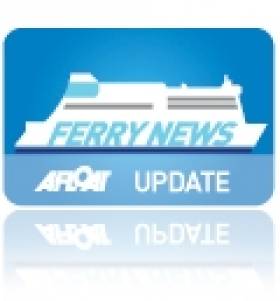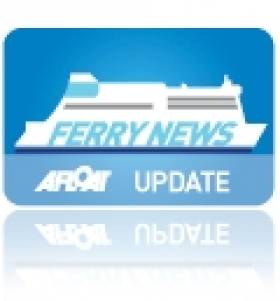Displaying items by tag: Kintyre Express
Second Route Resumes Service from Ballycastle Not to Rathlin Island.... But Scotland
#ScottishService - Ballyscastle, Co. Antrim not only has a ferry route to Rathlin Island but also to Scotland where the UK Prime Minister today is making a first campaign ahead of June's snap general election, writes Jehan Ashmore.
Operator, Kintyre Express since the Easter weekend resumed Scottish seasonal ‘passenger’ only services between Ballycastle and Campbeltown located close to the southernmost tip of the Mull of Kintyre. The 1 hour 30 minutes route caters for up to 12 passengers accommodated in the enclosed cabin of RedBay Stormforce 11 RIB craft.
In addition to running services to Port Ellen on Islay part of the Inner Hebrides. There is an option of a ‘Taste of the Islay tour’ where tourists can visit a whisky distillery. Those travelling with Kintyre Express can also take bikes free of charge to explore the stunning scenery of the Kintyre peninsula and that of Islay.
Pictured above is one of the operator’s craft, the KE IV berthed in the marina in Campbeltown. The marina is adjacent to the Campbeltown Fish Quay Improvement works project which was part financed by the EU’s European Regional Development Fund in partnership with the Scottish Government. The debate on the Common Fisheries Policy was one of the main vocal points raised by UKIP in advance to the Brexit vote on 23 June last year.
The sign is also a reflection of the current political situation facing Scotland, given last year’s Brexit vote of the referendum to remain on leave the EU. The majority of the Scottish electorate having voted to remain in the EU, however Theresa May is today expected to ask Scots to vote for her to "strengthen the Union", the economy and her hand in Brexit talks. Against this is the backdrop of First Minister of Scotland and SNP Leader Nicola Sturgeon who has demanded for a second referendum on Scottish independence.
Geographically the Mull of Kintyre is the closest point with Co. Antrim of 11 nautical miles. On this stretch of water a ‘car-ferry’ service had begun in 1997 linking Ballycastle and Campbeltown. The service operated by the Argyll and Antrim Steamship Packet Company, a subsidiary of Sea Containers UK, however was short-lived having run for just three seasons served by the former CalMac ferry Claymore (see related report CMAL's Canna serving Rathlin Island).
Claymore notable before her career with AA carried out a very unusual charter during the historic high-profile Irish visit in 1996 of USS John F. Kennedy aircraft carrier offshore of Dun Laoghaire Harbour. The unique visit of the 82,655 tons displacement aircraft carrier took place during the Northern Ireland Peace Process talks.
Claymore ferryied navy personnel and visitors between the anchorage in Dublin Bay and harbour. Such a sight was most odd given how out of context it was for both vessels to be in Irish waters.
#KintyreExpress – Fast RIB-craft passenger-only ferry operator, Kintyre Express resumes Ballycastle-Campbeltown services this month, and this will be their fourth season since making a debut in 2011, writes Jehan Ashmore.
Sailings of the 1 hour 30 minute crossing between Northern Ireland-Scotland operate every Friday, Saturday, Sunday and Monday. Departures from Ballycastle are 14.00 and from Campbeltown they depart two hours earlier at 12 noon.
The route is operated by locally built RedBay Stormforce high-speed RIB craft and all sailings operate on demand only - a minimum 4 booked passengers.
Single fares are £35 and for return tickets they are prices at £60. Bikes are carried free on all journeys. For further information telephone: 01586 555 895 or to book online visit: www.kintyreexpress.com
Severe Weather Disrupts Ferry Services
#FERRY NEWS – With travel disruption to some Irish Sea ferry services due to the severe weather conditions battering across the country, the following ferry operator's website links below provide the latest sailing schedules and contact details.
It is also advisable to contact the ferry operator to inquire about the port check-in time prior to setting off. For further information click over each of the route as highlighted below.
In addition to keep abreast of weather warning updates click www.met.ie/ and www.metoffice.gov.uk/
IRISH FERRIES
Central Reservations Tel: 0818 300 400 OR
Rosslare Tel: (053) 9133158
Rosslare-Cherbourg: Sailings have been temporarily suspended due to annual dry-docking of the cruiseferry Oscar Wilde. Sailings resume with the first departure in 2012 from Rosslare on 19th February and the corresponding return sailing from Cherbourg is scheduled for 21st February. For timetable click HERE.
STENA LINE
Tel: (01) 204 77 99 when travelling to Britain OR
Tel: 00 44 (0) 8705 755 755 when travelling to Ireland or Scotland.
Dun Laoghaire-Holyhead Note: the high-speed (HSS) route remains suspended until April or May 2012.
Belfast-Liverpool (Birkenhead)
P&O Ferries
Tel: 00 353 (0)1 407 3434
Larne-Troon. Note: the 'Express' fast-ferry craft operated route is due to re-open in March 2012.
KINTYRE EXPRESS
Tel: 00 44 1586 555 895
Note: FOOT-PASSENGER ONLY fast-RIB craft service which is currently operating to a winter service (October 2011-April 2012) which runs only on Friday's and Monday's.
CELTIC LINK FERRIES
Tel: (053) 916 2688
FASTNET LINE
Tel: (021) 437 8892 OR UK 00 44 (0) 844 576 8831
Note: The Celtic Sea route is due to re-open on 6th April 2012 with a sailing from Swansea.
New Passenger-Only Ferry for Northern Ireland-Scotland Route
Plans to operate the first passenger-only ferry service between Northern Ireland and Scotland are scheduled to start in late May, writes Jehan Ashmore.
Kintyre Express is to operate a Ballycastle-Campbeltown service on Fridays, Saturdays and Sundays between 27 May and 26 September. Three daily return trips are scheduled on the service though the 1200hrs sailing from Campeltown and the corresponding 1400hrs sailing from Ballycastle will only operate on customer demand.
The passage time is scheduled to take approximately 1 hour 30 minutes between County Antrim and the Mull of Kintyre which is a distance of some 50 kilometres / 30-miles. Ticket fares for a single journey are £30 and the return is £55. On the remaining days that the route is not operated on, the boat is available for private charter.
In addition the new venture is to include an on-demand Campbeltown-Troon route running between April and September. This second service, linking Argyll with Ayrshire, will operate on Sundays, Wednesdays and Fridays. The journey time is somewhat shorter with a scheduled time of 1 hour 15 minutes. The on-demand service must be booked in advance with singles fares costing £50 and a return ticket at £80. For further information click www.kintyreexpress.com
Like the recent proposals announced for a passenger-only ferry service across Galway Bay click here, the Kintyre Express operation will also use a fast-ferry in the form of rigid inflatable boats (RIB). The two routes from Campeltown will be served by Redbay Stormforce 11 metre RIBS which have centrally heated fully enclosed cabins for about 10 passengers. The Redbay Boats are built in Cushendall, Co. Antrim, for further information about the type of RIB to be used on the new routes click here.
The Ballycastle-Campbeltown route will be unique in that it will be the sole passenger-only ferry operator serving between the island of Ireland and the UK.
When the second route opens between Campbeltown-Troon, the company will be able to provide their boat service linked in with a train journey to Glasgow which they claim can be completed in less than two hours. Trains between Troon and Glasgow Central Station operate every 30 minutes and with a journey time of approximately 40 minutes.
For those who are car-free and time-free, this most northerly of travel routes is arguably the most scenic way to travel between Northern Ireland and Scotland and will appeal also to the intrepid traveler.
On both ferry services bicycles are carried for free and currently there is a special offer with all ferry tickets that can also be used for a free-day pass on the local Kintyre bus network for up to 24-hours. The bus operator is Craig of Campbeltown which trades as West Coast Motors and which owns Kintyre Express. The bus operator also serves on routes throughout Argyll and the island of Bute.
The next nearest cross-channel operator to the Kintyre Express Ballycastle-Campbeltown service is the car-carrying catamaran fast-ferry seasonal service between Larne and Troon operated by P&O (Irish Sea). The same company operates the year-round conventional car-ferry service on the North Channel between Larne and Cairnryan. Also operating to Loch Ryan is Stena Line which operates both ferry and HSS fast-craft services on the Belfast-Stranraer route.
Over the years there have been several attempts to revive the ferry between Ballycastle and Campeltown following a service that catered for vehicles too. For three summer seasons starting in 1997 the service was operated by the Argyll and Antrim Steam Packet Company, using the Claymore (1978/1,632grt) which could accommodate 500 passengers and 50 vehicles.
In 1996 the vessel was chartered to carry out tender duties for visitors and crew of the aircraft-carrier USS John F. Kennedy (displacement 82,655 tons full load) which was at anchor off Dun Laoghaire Harbour.































































